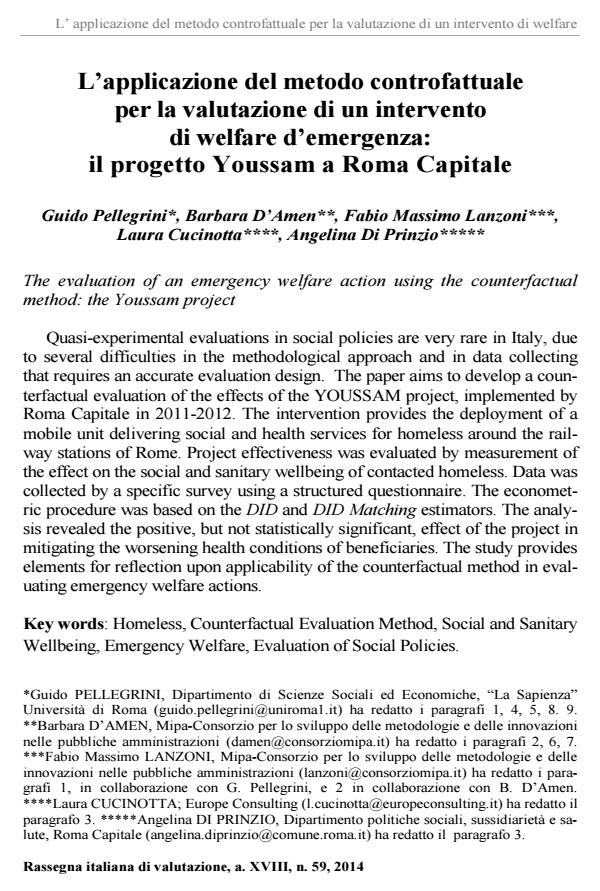L’applicazione del metodo controfattuale per la valutazione di un intervento di welfare d’emergenza: il progetto Youssam a Roma Capitale
Titolo Rivista RIV Rassegna Italiana di Valutazione
Autori/Curatori Guido Pellegrini, Barbara D'Amen, Fabio Massimo Lanzoni, Laura Cucinotta, Angelina Di Prinzio
Anno di pubblicazione 2015 Fascicolo 2014/59
Lingua Italiano Numero pagine 24 P. 124-147 Dimensione file 181 KB
DOI 10.3280/RIV2014-059007
Il DOI è il codice a barre della proprietà intellettuale: per saperne di più
clicca qui
Qui sotto puoi vedere in anteprima la prima pagina di questo articolo.
Se questo articolo ti interessa, lo puoi acquistare (e scaricare in formato pdf) seguendo le facili indicazioni per acquistare il download credit. Acquista Download Credits per scaricare questo Articolo in formato PDF

FrancoAngeli è membro della Publishers International Linking Association, Inc (PILA)associazione indipendente e non profit per facilitare (attraverso i servizi tecnologici implementati da CrossRef.org) l’accesso degli studiosi ai contenuti digitali nelle pubblicazioni professionali e scientifiche
Quasi-experimental evaluations in social policies are very rare in Italy, due to several difficulties in the methodological approach and in data collecting that requires an accurate evaluation design. The paper aims to develop a counterfactual evaluation of the effects of the YOUSSAM project, implemented by Roma Capitale in 2011-2012. The intervention provides the deployment of a mobile unit delivering social and health services for homeless around the railway stations of Rome. Project effectiveness was evaluated by measurement of the effect on the social and sanitary wellbeing of contacted homeless. Data was collected by a specific survey using a structured questionnaire. The econometric procedure was based on the DID and DID Matching estimators. The analysis revealed the positive, but not statistically significant, effect of the project in mitigating the worsening health conditions of beneficiaries. The study provides elements for reflection upon applicability of the counterfactual method in evaluating emergency welfare actions.
Parole chiave:Homeless, Counterfactual Evaluation Method, Social and Sanitary Wellbeing, Emergency Welfare, Evaluation of Social Policies
Guido Pellegrini, Barbara D'Amen, Fabio Massimo Lanzoni, Laura Cucinotta, Angelina Di Prinzio, L’applicazione del metodo controfattuale per la valutazione di un intervento di welfare d’emergenza: il progetto Youssam a Roma Capitale in "RIV Rassegna Italiana di Valutazione" 59/2014, pp 124-147, DOI: 10.3280/RIV2014-059007